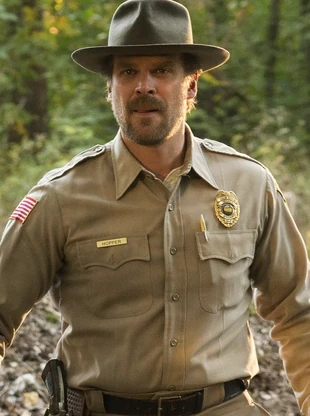Narratology
Narratology can be defined as a ‘branch of knowledge or criticism that deals with the structure and function of narrative and its themes, conventions, and symbols’.
This analysis of narrative can be broken down into a number of ways:
narrative structures
narrative endings
story beats
character arcs
1. How is the episode, and the way the events unfold within it, structured?
The episode relates to Todorov’s narratology theory as at the beginning of the episode the equilibrium is established through the group of boys playing dungeons and dragons. As the episode continues this equilibrium is disrupted as Will Byers disappears after being chased by an unknown presence which, after the realisation of the equilibrium, leads to a police investigation. The attempt to resolve the disruption is illustrated as the group of boys search for Will by themselves as they acknowledge that the police are inefficient. As this is only one episode in the series the disruption has not yet been resolved as Will has not been found which therefore discredits Todorov’s theory however we can assume that there will be a resolution and therefore a new equilibrium in later episodes. In some elements the episode does not relate to Todorov's theory as the structure alternates due to multiple storylines which creates multiple equilibriums (for example Hopper's equilibrium would be waking up on the sofa and going to work expecting little work however this is disrupted with the disappearance of Will).
2. How does the episode begin and finish?
The episode beings with an establishing shot of a night sky and a industrial and utilitarian building followed by a tracking shot of a scientist running from an unknown threat. This shot establishes the setting and the villain through what we perceive to be the death of an innocent as the shot changes just before the monster reaches the scientist. The broken lighting and dark atmosphere relates closely to the horror genre and links with 80s films such as Close Encounters Of The Third Kind and Alien. The episode then ends with a similar eerie atmosphere as the group of boys search for Will with torches relating to E.T
3. What are the story beats between the beginning and end of the episode?
Story beats are the points of action upon which you hang your basic story. When you connect the actual individual action points, they build up to story, like a puzzle. These are the story moments that are the X happens, and then Y happens… and then Z happens… and on.
The scientist is chased by the monster
Mike, Will, Lucas and Dustin play dungeons and dragons in Mike's basement.
Dustin offers pizza to Nancy
The boys leave on bikes and argue over comics
Will bikes off and falls
He is chased by a monster and runs into the shed
the light in the shed flashes and Will disappears
Joyce Byers rings Karen (Mike's mum) and the disturbance of the equilibrium is established
The scene changes to Hopper waking up on a sofa
He arrives at work to Joyce in a panic about her son
Mike, Dustin and Lucas arrive at school
Nancy and Steve 'make out' in the bathroom as Nancy is late for her lesson
Mr Clarke shows the boys the radio
The headmaster calls the boys into his office where they are questioned by Hopper
Eleven runs into a diner and steals chips
The chef threatens her then attempts to gain her trust as he rings social services
Hopper searches Wills house
4. How is the pace set by the narrative structure and the events as they unfold? Does this support or challenge the narrative conventions of the genre?
5. Are there multiple story-lines and how are these set up within the narrative structure? What are the benefits of multiple story-lines?
6. How can these help to develop the media form of Long Form TV Drama?
7. How can these additional story-lines attract an audience?
8. How effective is this structure in the way in which it communicates multiple meanings? Refer to examples from Stranger Things.
9. How does the chosen narrative structure help reinforce the genre conventions (science-fiction/horror) of the product?
Alexcia Ward's A Level Media
Thursday, 28 February 2019
Wednesday, 27 February 2019
TV Drama: Context
Context in relation to a media text can be broken down into the following: social, historical, cultural, economical and political.
Social and cultural context
Society is a community within which people live and interact with one another.
Social refers to the people who live in a specific place and interact with one another within the social environment. Social contextrefers to these people and the structure and function of institutions that operate within a society such as family, education, religion, communications, government etc... It also helps us to understand social conflicts that may arise as a result of the structure, functions and interactions of the people who live within it. We all live our day to day lives in the same society following the same structures and functions. Social context focuses on the relationship between media products and the society within which they are made in relation to social groups, attitudes, changes, conflicts and inequalities.
Culture is the way the different people who live in that society behave - you can have one society or social structure (American, British, Swedish, German) but many cultures or sub-cultures within that society.
Cultural refers to what creates the identity of the people who live in any given society. Culture refers to the beliefs, meanings and practices that guide the shared behaviour of individuals within a group in any given society. This includes the attitudes, values, habits, customs and traditions of the shared culture. Culture can be seen to include all aspects of ‘life’ including language, the products we make, the things we do and how we do them. There can be lots of different cultures and sub-cultures within a society, which is why we might all behave, think and act a little bit differently even though we are all living our day to day lives in a similar way.
Social refers to the people who live in a specific place and interact with one another within the social environment. Social contextrefers to these people and the structure and function of institutions that operate within a society such as family, education, religion, communications, government etc... It also helps us to understand social conflicts that may arise as a result of the structure, functions and interactions of the people who live within it. We all live our day to day lives in the same society following the same structures and functions. Social context focuses on the relationship between media products and the society within which they are made in relation to social groups, attitudes, changes, conflicts and inequalities.
Culture is the way the different people who live in that society behave - you can have one society or social structure (American, British, Swedish, German) but many cultures or sub-cultures within that society.
Cultural refers to what creates the identity of the people who live in any given society. Culture refers to the beliefs, meanings and practices that guide the shared behaviour of individuals within a group in any given society. This includes the attitudes, values, habits, customs and traditions of the shared culture. Culture can be seen to include all aspects of ‘life’ including language, the products we make, the things we do and how we do them. There can be lots of different cultures and sub-cultures within a society, which is why we might all behave, think and act a little bit differently even though we are all living our day to day lives in a similar way.
Social Contexts
Social Contexts within Stranger Things
The episode intertextually reflects 1980s family and gender relations and is set within a Speilbergian, mostly white, world of suburban family life, representing mothers as figures struggling to hold the family together, fathers as absent or insensitive and distracted, and young boys as establishing a fierce loyalty and masculine camaraderie in the face of a hostile world. Mike’s teenage sister, Nancy, is represented in contradictory ways: she anti-stereotypically excels at science while still fitting stereotypes of the teenage girl (reflecting theories such as Gauntlett). The episode shows the influence of social anxieties about the consequences of scientific experimentation.
In which country is the drama set?
America but set in the fictional rural town of Hawkins, Indiana
In which country is the drama made?
filmed on location in Atlanta, Georgia and surrounding towns and areas. Many of the interior sets were built and filmed on sound stages in EUE Screen Gems Studios in Atlanta.
What is the social identity of the people in the drama?
Suburban white American families in a small town. Mike's family = middle class. Will's = working class.
Who makes the drama?
Produced as a Netflix series but created by the Duffer Brothers and 21 laps.
Are they a small independent organisation or a large multi-national / global conglomerate?
Netflix is a multi-million company founded by Reed Hastings and Marc Randolph on August 29, 1997, in Scotts Valley, California. It specialises in and provides streaming media and video-on-demand online and DVD by mail. In 2013, Netflix expanded into film and television production, as well as online distribution. As of 2017, the company has its headquarters in Los Gatos, California.
The Duffer Brothers also directed the series as they have with other productions of theirs. On August 31, 2016, Netflix renewed the series for a second season of nine episodes, to be released on Halloween of 2017.
How is the social identity of the country of production reflected in the drama?
What aspects of social and day to day life are reflected in the drama (being with families, going to school, legal and political systems, being religious etc.)?
How are these structures reflected in the drama – as usual or to be questioned?
The destruction of the nuclear family and representation of Joyce and her family represents the lack of structure reflected in the drama. Will's disappearance is arguably a factor of Joyce's unavoidable neglect as she struggles to support her family as she works night shifts along with Will's brother working to support the family as the male figure. This social and political factor is questionable as Will is left alone at a young age. Another questionable structure is the close-knit relationship between Mr Clarke and Dustin, Lucas and Mike as they partake in extra-curricular activities with the radio as the teacher acts more as a friend or paternal figure.
How does the drama influence our own participation within the social structure (confirms it as the right thing to do or questions it?)
?
?
Is there any social conflict apparent in the drama?
There is only a slight social conflict presented in the drama through two instances; Will's family and the two bullies at school. The lack of a nuclear family creates social conflict as Will does not appear to have a dad who is around and the family is therefore troubled for money. The school bullies cause social conflict through name calling and possible racism as they refer to Lucas as 'Shadow'.
How does the drama represent social changes?
As reflected in the settings and characters within the drama (1980s):
What do we see people doing in the drama?What attitudes, values, habits, customs and traditions can we see them taking part in that identifies their culture (as American, Germans, Danes etc…)?
What do they wear?
How do they speak?
How do they spend their spare and recreational time?
What do we see them listening to or watching?
What do they eat?
Where do they go out?
How do they interact with one another?
What values or beliefs are they seen to hold?
What intertextual references to other cultural products are there?
How do audiences consume and interact with products (either of the set drama itself or how we see them consuming media within the drama)?
As reflected at the time of the drama’s production (2016):
How does the set product typify cultural trends and preferences of what audiences like to watch?How do audiences consume and interact with the products? How have current cultural trends and uses of technology influenced this?
How does the viewer’s own cultural background or social identity affect the way in which they may respond to and interpret the drama?
How does the drama support or reinforce the cultural background of its target audience?
Historical Contexts:
When was the drama set?
What significant events or issues happened politically, socially, culturally at that time? Write a list.
Does the drama represent or refer to any historical events?
Political Context:
What is the political context at the time in which the product is set or made (e.g. political leadership at the time, significant political events or issues)?
Is there any political conflict evident in the drama?
How does the drama reflect political debates and issues?
Could the drama be seen to influence political debates and the way in which its viewers may think or feel about these political issues?
How is political power seen to be used or achieved in the drama?
Does the drama contribute to shaping ideas about politics and political power?
How could the political climate in which the audience watch the drama affect their own response?
Economic Context:
How is the company that made the drama funded?
What income revenues do they have?
What is the budget for the drama?
How does the owner(s) of the product use or develop processes of production, distribution and circulation?
How successful is the company in comparison to others in the market? What profit have they made?
What technological developments have there been that allows the current processes of production, distribution and circulation?
What developments in technology may there be that could change processes of production, distribution and circulation?
The contexts in which the drama is set:
When and where is the drama set?
What genre is the product?
What is the political, social and cultural climate that the drama is set in?
Are there any intertextual references to other media products, historical eras, and social identities?
How are these represented in the drama?
How accurate are these representations to the real event or issue?
What viewpoint or ideological messages do they offer?
How may the meanings constructed by the product be interpreted by different audiences?
The contexts in which the drama is produced:
When and where was the set product produced?
Who owns and distributes the set product?
What other dramas do they produce?
What was the budget for the set product?
Do the dramas they produce offer similar representations?
Are there any intertextual references in the first episode of the set product?
How is the set product distributed? On what platforms?
Is the product available globally? Which countries isn’t it available in and why is this?
What circulation platforms are there? How is the product viewed and consumed?
Who is the target audience? Which wider audiences might enjoy the product?
How can audiences access and consume the set product?
How was the drama received in different countries?
How might their viewing contexts affect what they view and how they interact with the product?
Which factors might affect the interpretation of meaning for different audiences of the same product?
Friday, 8 February 2019
TV Drama Industry
Who is the owner of the product?
Who are they? How are they structured as a company? Do they own any other companies or are they owned by another company or conglomerate?
Are they a specialised company? What other similar products do they/have they produced? How successful are they?
How are they funded? Where does the company’s funding come from?
Are they vertically or horizontally integrated?
How have they diversified?
What aspects of the production, distribution and circulation processes do they own?
How do they ensure their product is distributed and circulated?
How does this help with funding their products?
How does this help to reach and maintain audiences?
How do they reach their audience?
Do they have global reach? How many viewers/subscribers do they have? How many viewers have there been for the drama and/or the first episode of the first season?
How do they measure their audience?
How do they maintain their audience?
How does the organisation market their brand to the audience?
How do they market the product to the audience? Can the drama be seen to be innovative programming that their audiences will enjoy?
Friday, 25 January 2019
Semiotics, Signs and Signifiers
What is semiotics and how does it help us analyse and understand representations in the media?
The study of signs/signals and their significance of understanding what they represent within a media product which helps us to analyse and understand why certain things are put in place.
What are media signs and signifiers?
In semiotics, a sign communicates a meaning that is not the sign itself to the interpreter of the sign. The meaning can be intentional or unintentional.
The sign is the object or thing being seen. The signifier is the physical existence (sound/word/image) and the signified is the mental concept.
What key signs and signifiers can be seen in episode one of each of the set products?
One signifier is the use of darkness which can be interpreted into the horror genre in which there are 3 key scenes. One being where Will gets taken by the 'antagonist' which sets the scene for a horror genre. Another scene is the opening with the stars and dark science lab where the lights are flickering which creates a mysterious tone with underlying tension from the unknown of the darkness which emphasises evil, mystery and fear.
Other signifiers in Stranger Things include the different houses, for example, Will has a small bungalow type house with little luxuries which can be interpreted into the idea that Will's family is quite poor, emphasising the reason for being in an 'outcast' group with his friends as they play dungeons and dragons which is seen as geeky as well as their clothing. This, as well as other signs such as the bullies at school, clearly shows that the main group that the audience follows are unpopular which is clearly established. In contrast to Will, Mike
How do these help to communicate messages and values about the individuals, social groups, social identities, events and issues conveyed in the dramas?
What are connotations? How do the representations offered connote the same or different values, attitudes and ideological beliefs about the world? Why do we recognise these connotations? Are they reinforced across a wide range of media representations or do the representations offer new messages and values?
Wednesday, 23 January 2019
Realism
Realism
What is realism and how is it different to reality?
How can realism be defined? What is realism and why it is used by media producers?
How conventional or important is realism in Long Form TV Drama and the drama’s success?
How is the drama constructed - how do media producers construct realism? Which elements of media language enable constructed realism to claim to be ‘real’?
How are the representations of individuals, social groups, social identities, events and issues constructed as real? Refer to specific examples.
Wednesday, 16 January 2019
Character Analysis
Joyce Byers
- Joyce is a major character, she is Will Byers mum who reports her son missing to Jim Hopper
- She conforms to the single parent stereotype, as she has to work long ours to support her family, as well as her eldest son having to work, to also help pay for things.
- Erratic, wants to find will, doesn't sleep, works hard
- She is Will's mum and reports him missing. She is constantly looking for him and doesn't stop until she finds him.
- Jim is a major character, as he is the sheriff of the town. He is in charge of the missing persons case (Will Byers).
- He conforms to the stereotype of the male gender.. lazy, negative, not emotional however, on the other hand he is the stereotype of a sheriff and initiates a search party for Will.
- Lazy, Does not look after himself, alone, want to find will, messy
- He is the sheriff in charge of Wills missing person case and has to use all methods to find him (that are in his power).
Mike Wheeler
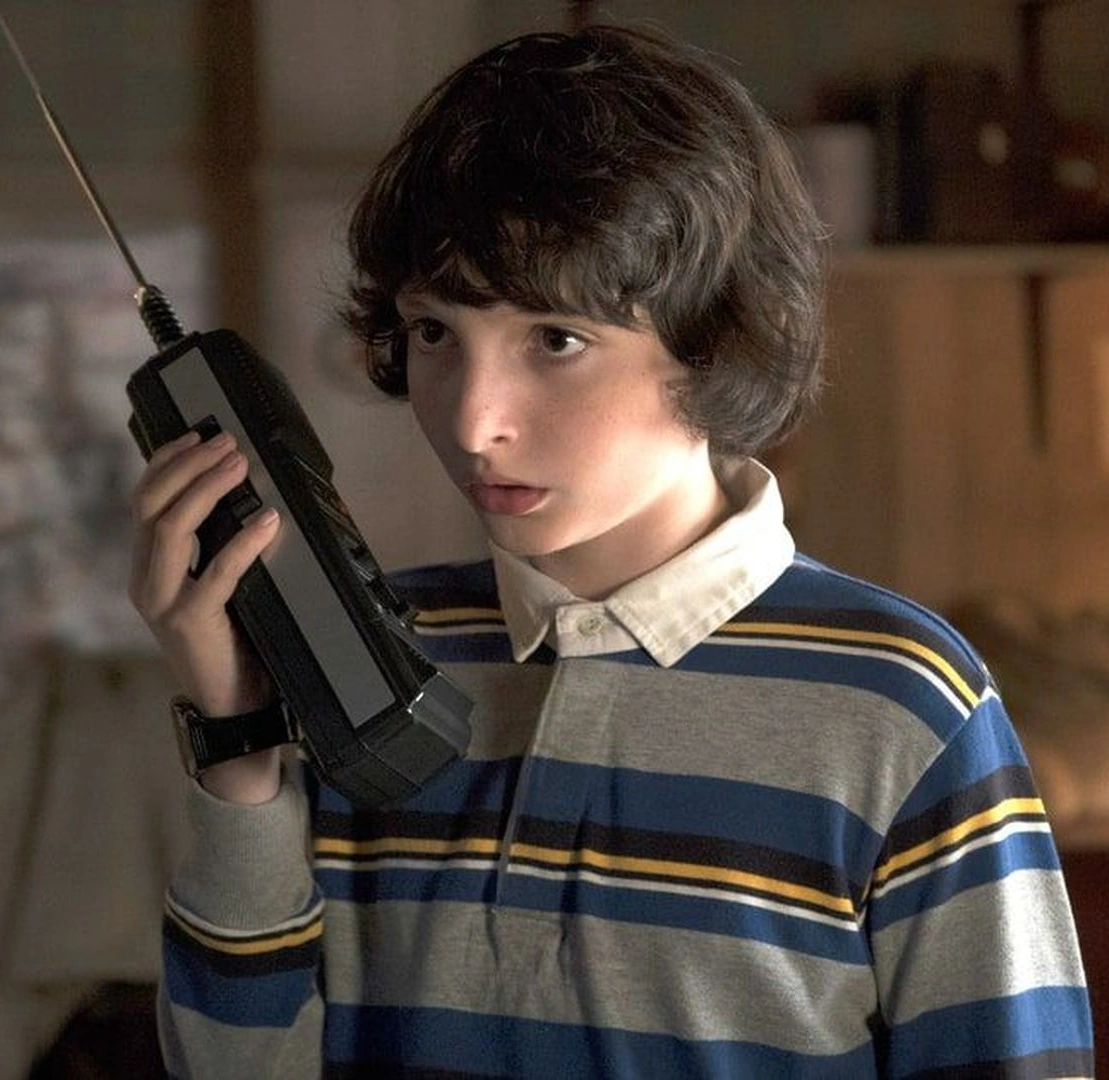
- Major character, as he is one of the four main young characters. The TV series starts at Mike's house and they are playing a board game (dungeons and dragons).
- Conforms to the stereotype of a young boy, as he is curious and adventures and brave. He wants to find Will Byers and does not think that the adults have done anything.
- He is brave, young and wants to find out what happened to his friend, Will Byers.
- He is one of the five main kids in the television series, who is trying to find out what happened to Will Byers and why he is missing.
Dustin Henderson
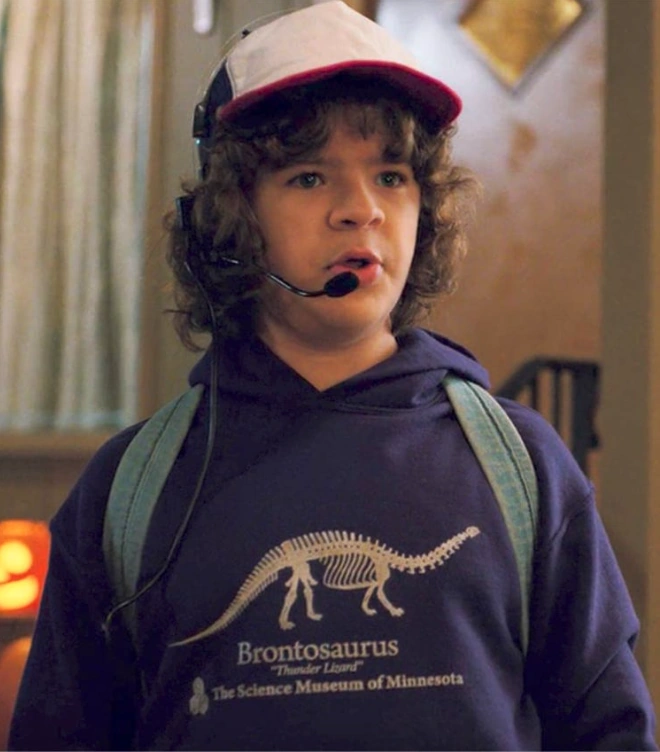
- Major character, he is one of the four main young characters. He is in one of the first scenes of the TV series. he is seen playing a board game (dungeons and dragons) with the rest of the kids, in Mike Wheeler's house
- Conforms to the stereotype of a young boy, as he is curious and adventures and brave. He wants to find Will Byers and does not think that the adults have done anything.
- He is young,brave and follows what the rest of the boys do. He is worried about what consequences of the actions will have. However, he still wants to find Will and make sure that he is okay.
- He is one of the five main kids in the television series, who is trying to find out what happened to Will Byers and why he is missing.
Lucas Sinclair
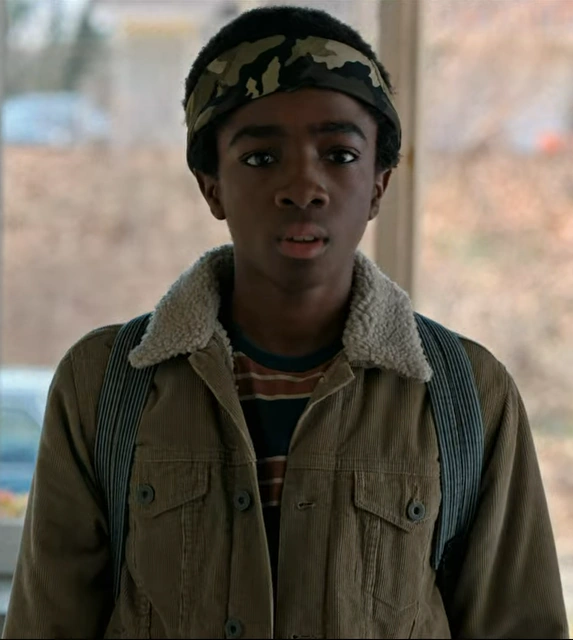
- Major character, he is one of the four main young characters. He is in one of the first scenes of the TV series. he is seen playing a board game (dungeons and dragons) with the rest of the kids, in Mike Wheeler's house
- Conforms to the stereotype of a young boy, as he is curious and adventures and brave. He wants to find Will Byers and does not think that the adults have done anything.
- He is young,brave and follows what the rest of the boys do. He is worried about what consequences of the actions will have. However, he still wants to find Will and make sure that he is okay.
- He is one of the five main kids in the television series, who is trying to find out what happened to Will Byers and why he is missing.
Will Byers
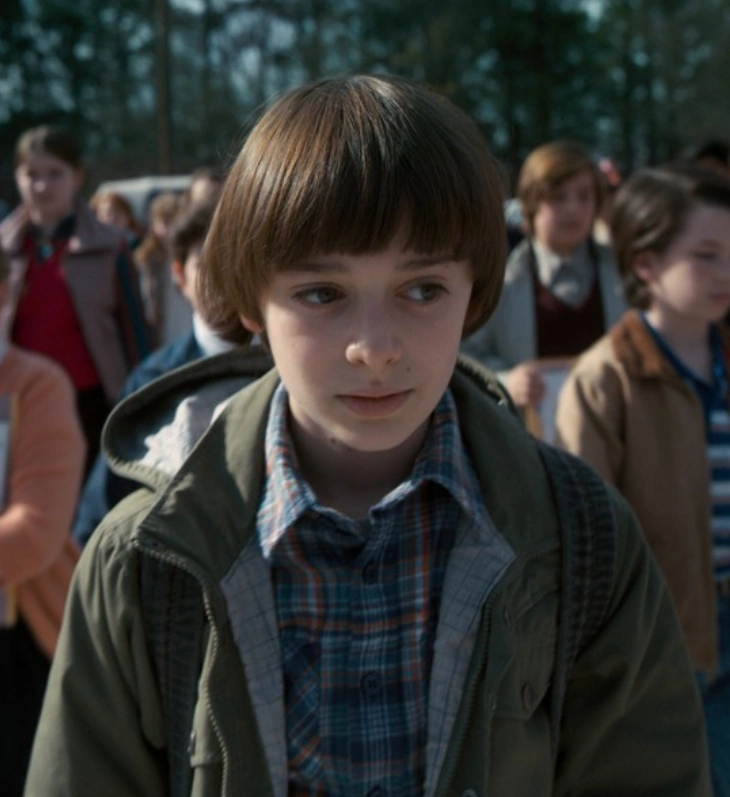
- The main character, the whole television series is based on Will Byers being missing, therefore he is a major character and one of the most important. He is in one of the first scenes of the TV series. he is seen playing a board game (dungeons and dragons) with the rest of the kids, in Mike Wheeler's house.
- Conforms to the stereotype of a young boy, as he is curious and adventures and brave. He also cycles home by himself, which again shows that he is brave, even though he manages to go off of the road and run home, when something was following him.
- He is quite unique and mysterious. He also does not have much of a background, which is why it is confusing and mysterious why he was the only boy to have gone missing.
- He is the boy that went missing and everyone else is trying to find where he is and why he has gone.
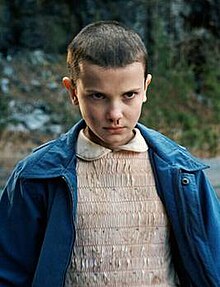 Eleven
Eleven
- Major main character, at the end of the episode the boys find her running though the forest and then it ends there,on a cliff hanger.
- Counter-stereotype , shaved hair, perceived masculine
- Supernatural, quiet, mysterious, scared, powerful
- Secondary story line for the narrative, eventually helps to look for Will, but only later on in the series.
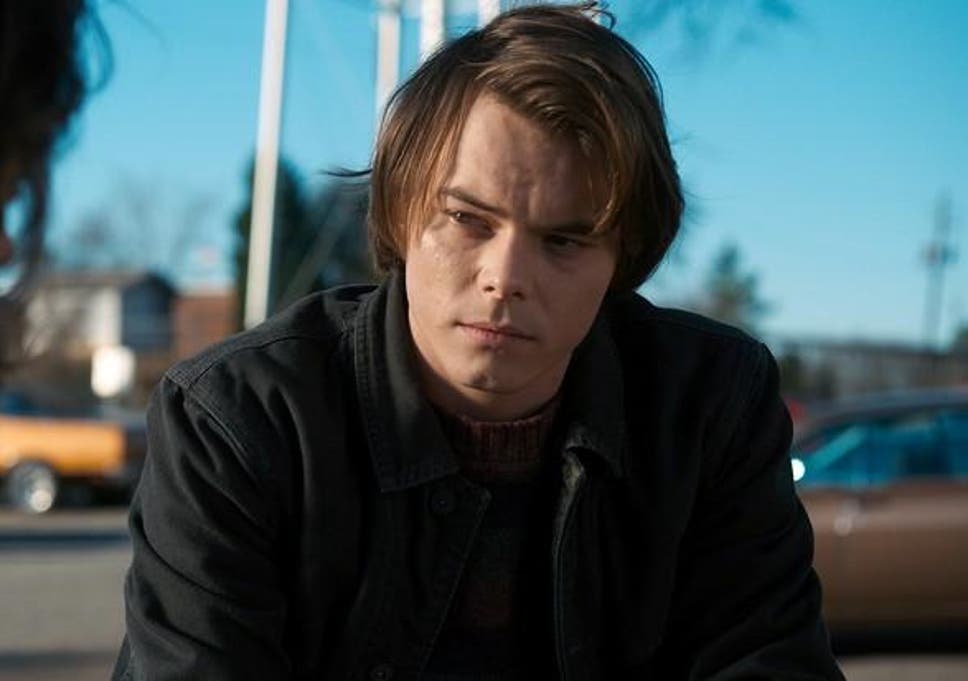
Johnathan Byers
- Secondary main character
- Stereotype of an older brother, out working, however emotional and concerned when Will disappears
- Worried, helpful and sorrowful
- Is a secondary character to the narrative in relation to the main character
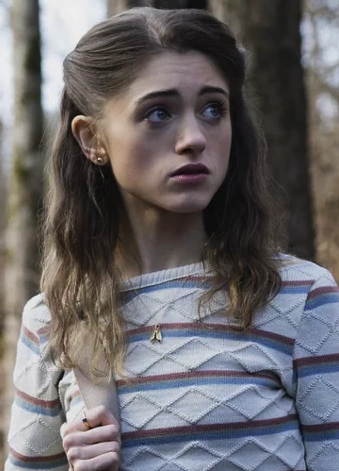
Nancy Wheeler
- She is not a major character in episode one, as she is part of a sub-plot
- Stereotype of an older sister and also a stereotype of a girl, wearing light colours, focusing on her education and not as much on boys (Steve Harrington).
- Rude to Dustin, kind to the people her age, has arguments with her brother.
- Her younger brother is Will Byers friend. Throughout the series she becomes more of a major character, than a secondary main character. Nancy contributes to the narrative more during the television series, rather than in the first episode, she becomes more involved with Will's missing persons case further along in the television series.
Steven Harrington
Barbara Holland
Benny Hammond
Scientists
They play a minor role in the first episode as they only really appear in the opening scene, but do play a big part in the way that they know what the audience don't in terms of the unknown being that has escaped.
They are very stereo-typically 'scientists' as they even wear the white lab coats and identification cards, and the only setting they really appear in in the first episode is a lab/government facility, which makes the audience recognise that they are scientists.
We only briefly see them so only get to see the stereotypical scientist persona of them all, but see them mainly as very smart and intuitive.
They set out the opening scene by showing a scientist running from the unknown monster and it leaves the audience in a position of ignorance as we don't know what this scientist is running from. This monster then goes on to abduct Will Byers which is the main story line of the episode.
Ted Wheeler
He is a relatively minor character and only really appears in the scene of the family dinner where he plays the character of the disinterested father.
He conforms to the Stereotypes of a father during the 80s due to his professional attire and big round glasses, but also holds the stereotype of a father in the 80s as he has little interest in anything but his life and tries to ignore what is going on in his children's.
Karen Wheeler
Joyce Byers
- Joyce is a major character, she is Will Byers mum who reports her son missing to Jim Hopper
- She conforms to the single parent stereotype, as she has to work long ours to support her family, as well as her eldest son having to work, to also help pay for things.
- Erratic, wants to find will, doesn't sleep, works hard
- She is Will's mum and reports him missing. She is constantly looking for him and doesn't stop until she finds him.

- Jim is a major character, as he is the sheriff of the town. He is in charge of the missing persons case (Will Byers).
- He conforms to the stereotype of the male gender.. lazy, negative, not emotional however, on the other hand he is the stereotype of a sheriff and initiates a search party for Will.
- Lazy, Does not look after himself, alone, want to find will, messy
- He is the sheriff in charge of Wills missing person case and has to use all methods to find him (that are in his power).
Mike Wheeler
- Major character, as he is one of the four main young characters. The TV series starts at Mike's house and they are playing a board game (dungeons and dragons).
- Conforms to the stereotype of a young boy, as he is curious and adventures and brave. He wants to find Will Byers and does not think that the adults have done anything.
- He is brave, young and wants to find out what happened to his friend, Will Byers.
- He is one of the five main kids in the television series, who is trying to find out what happened to Will Byers and why he is missing.

Dustin Henderson
- Major character, he is one of the four main young characters. He is in one of the first scenes of the TV series. he is seen playing a board game (dungeons and dragons) with the rest of the kids, in Mike Wheeler's house
- Conforms to the stereotype of a young boy, as he is curious and adventures and brave. He wants to find Will Byers and does not think that the adults have done anything.
- He is young,brave and follows what the rest of the boys do. He is worried about what consequences of the actions will have. However, he still wants to find Will and make sure that he is okay.
- He is one of the five main kids in the television series, who is trying to find out what happened to Will Byers and why he is missing.

Lucas Sinclair
- Major character, he is one of the four main young characters. He is in one of the first scenes of the TV series. he is seen playing a board game (dungeons and dragons) with the rest of the kids, in Mike Wheeler's house
- Conforms to the stereotype of a young boy, as he is curious and adventures and brave. He wants to find Will Byers and does not think that the adults have done anything.
- He is young,brave and follows what the rest of the boys do. He is worried about what consequences of the actions will have. However, he still wants to find Will and make sure that he is okay.
- He is one of the five main kids in the television series, who is trying to find out what happened to Will Byers and why he is missing.

Will Byers
- The main character, the whole television series is based on Will Byers being missing, therefore he is a major character and one of the most important. He is in one of the first scenes of the TV series. he is seen playing a board game (dungeons and dragons) with the rest of the kids, in Mike Wheeler's house.
- Conforms to the stereotype of a young boy, as he is curious and adventures and brave. He also cycles home by himself, which again shows that he is brave, even though he manages to go off of the road and run home, when something was following him.
- He is quite unique and mysterious. He also does not have much of a background, which is why it is confusing and mysterious why he was the only boy to have gone missing.
- He is the boy that went missing and everyone else is trying to find where he is and why he has gone.

 Eleven
Eleven- Major main character, at the end of the episode the boys find her running though the forest and then it ends there,on a cliff hanger.
- Counter-stereotype , shaved hair, perceived masculine
- Supernatural, quiet, mysterious, scared, powerful
- Secondary story line for the narrative, eventually helps to look for Will, but only later on in the series.

Johnathan Byers
- Secondary main character
- Stereotype of an older brother, out working, however emotional and concerned when Will disappears
- Worried, helpful and sorrowful
- Is a secondary character to the narrative in relation to the main character

Nancy Wheeler
- She is not a major character in episode one, as she is part of a sub-plot
- Stereotype of an older sister and also a stereotype of a girl, wearing light colours, focusing on her education and not as much on boys (Steve Harrington).
- Rude to Dustin, kind to the people her age, has arguments with her brother.
- Her younger brother is Will Byers friend. Throughout the series she becomes more of a major character, than a secondary main character. Nancy contributes to the narrative more during the television series, rather than in the first episode, she becomes more involved with Will's missing persons case further along in the television series.
Steven Harrington
Barbara Holland
Benny Hammond
Scientists
They play a minor role in the first episode as they only really appear in the opening scene, but do play a big part in the way that they know what the audience don't in terms of the unknown being that has escaped.
They are very stereo-typically 'scientists' as they even wear the white lab coats and identification cards, and the only setting they really appear in in the first episode is a lab/government facility, which makes the audience recognise that they are scientists.
We only briefly see them so only get to see the stereotypical scientist persona of them all, but see them mainly as very smart and intuitive.
They set out the opening scene by showing a scientist running from the unknown monster and it leaves the audience in a position of ignorance as we don't know what this scientist is running from. This monster then goes on to abduct Will Byers which is the main story line of the episode.
Ted Wheeler
He is a relatively minor character and only really appears in the scene of the family dinner where he plays the character of the disinterested father.
He conforms to the Stereotypes of a father during the 80s due to his professional attire and big round glasses, but also holds the stereotype of a father in the 80s as he has little interest in anything but his life and tries to ignore what is going on in his children's.
He conforms to the Stereotypes of a father during the 80s due to his professional attire and big round glasses, but also holds the stereotype of a father in the 80s as he has little interest in anything but his life and tries to ignore what is going on in his children's.
Karen Wheeler
Wednesday, 9 January 2019
Deutschland 83: The Cold War
The Cold War
- The dispute was between the Soviet Union (USSR)and the US. It escalated due to antagonist values between the United States, representing capitalism and democracy, and the Soviet Union, representing communism and authoritarianism.
- The war lasted from 1947 to 1991.
- States in the west much richer and those in the East had lower wages. More women work in the east than the west. The east also had less choice of food supplies in shops whereas the west had luxuries of global food such as fruit. There are also more migrants in the west of Germany. Because East Germany was inland, they did not have the access to imports that West Germany had. This resulted in different produce being available in one and not in the other.The East was also largely communist as the USSR had control over it, whilst the West was Capitalist. This meant that people would have been generally poorer in the East as wealth is shared equally in communist states, whilst the West would have been quite prosperous. Also, the East would have been under a dictatorship whilst the West would have been democratic.
- The NATO (North Atlantic Treaty Organization) commenced a 10-day exercise codenamed Able Archer 83. It involved most of Western Europe and was directed from Supreme Headquarters Allied Powers Europe (SHAPE) at Casteau, Belgium. Able Archer was a complex simulation of a hypothetical war with the Warsaw Pact that included a series of fictional military exercises escalating to the launch of nuclear weapons
Subscribe to:
Comments (Atom)
